Wiesbaden offers a unique blend of historic elegance and modern relaxation, making it an ideal getaway for those seeking a mix of culture and rejuvenation.
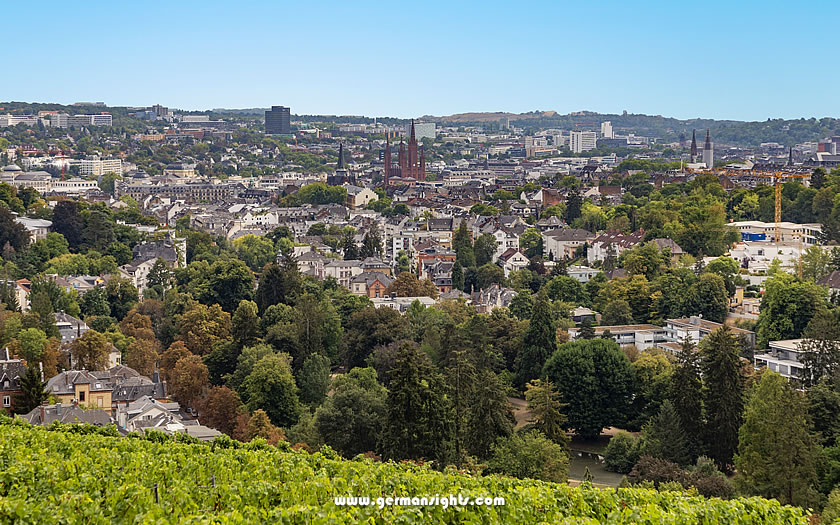
A view over Wiesbaden from the Neroberg hill
As you stroll through the city centre, you'll notice the grand 19th-century buildings, remnants of Wiesbaden's past as a fashionable spa town. The Wiesbaden Kurhaus, with its ornate facade, stands as a centrepiece of this architectural heritage.
The city's thermal springs, which have drawn visitors for centuries, are still a major attraction. You can experience these healing waters in various spas and bathhouses throughout the city.
The nearby Rheingau wine region provides opportunities for wine tasting and scenic walks through vineyards.
The city's pace is generally unhurried, allowing visitors to explore at their leisure. But it's worth noting that Wiesbaden does not have the bustling nightlife of larger German cities.
Wiesbaden is situated in the western part of central Germany, on the Rhine river in the state of Hesse.
The historic spa city is the state capital, although it is dwarfed by nearby Frankfurt am Main, just 40 kilometres to the east. Wiesbaden is also well-connected to other major German cities like Mainz (just across the Rhine) and Darmstadt.
Frankfurt Airport (FRA) is the closest major international airport to Wiesbaden and is by far the best option for most travelers. It offers a wide range of flights from around the world and has excellent transport connections to Wiesbaden.
Distance to Frankfurt Airport: 26km
Distance to Frankfurt Hahn Airport: 88km
Distance to Luxembourg Airport: 195km
Distance to Stuttgart Airport: 220km
Frankfurt Hahn Airport isn't anywhere near Frankfurt; it's actually on the other side of Wiesbaden to the west. It's mostly used by budget airlines, so it's a good choice for people who want to save money, even though the trip to Wiesbaden might take a bit longer.
Luxembourg Airport is farther away, but it can be a good option too. It's especially useful if you're visiting Wiesbaden and also traveling to Belgium, the Netherlands, or Luxembourg.
Frankfurt Airport, being one of the busiest in Europe, offers the most extensive range of international and domestic flights. Its proximity and direct train connections make it the most convenient choice for most visitors to Wiesbaden.
The main train station in Wiesbaden ('Wiesbaden Hauptbahnhof') is located just south of the central Wiesbaden Mitte district, with easy access to the more historic buildings and museums.
Wiesbaden is part of the Rhein-Main S-Bahn network (suburban rail) and three of the lines (S1, S8 and S9) terminate in Wiesbaden. All of them run through the main Frankfurt Hauptbahnhof, so there are frequent connections into the big city.
Two of the lines serve Frankfurt Airport, and the S-Bahn services also link Wiesbaden to other important regional centres such as Mainz, Darmstadt, Offenbach and Hanau.
There are also direct InterCity and ICE (InterCity Express) connections to major German cities such as Munich and Cologne.
Additionally, there are regional train services along the Rhine valley, connecting Wiesbaden with cities like Koblenz and Mannheim.
The German rail service offers a ticket ('Hessenticket') which includes unlimited travel for a day for up to five passengers on regional trains and bus services in Hessen.
Wiesbaden is well-connected into the German motorway system, even if the high-speed roads are some of the busiest in the country.
The A-66 motorway runs through the south of Wiesbaden heading from the Rheingau region in the west towards the city of Frankfurt and onwards to Fulda.
The Wiesbadener Kreuz just before Frankfurt is where the east-west A-66 crosses the north-south A-3, which runs between Cologne and Würzburg. This is one of the busiest junctions in the whole of the country and also the cut-off point for those heading towards Frankfurt Airport.
The A-643 also runs south over the Rhine river to connect to Mainz (one of several alternative ways) before joining up with the A-60 down to Mannheim and Heidelberg.
Most tourists will find that staying in the city centre is the most convenient option. You can easily get to many of the sights and attractions in Wiesbaden and the train station for day trips further afield is only a short walk.
As a mid-sized Germany city and somewhere famous for its spa tourism, Wiesbaden has plenty of accommodation options. If you are looking for somewhere unique for a luxury splurge, the five-star superior Nassauer Hof is located right in the centre next to the Schlosspark and has been on the go since the early 1800s. It also has its own spa facilities.
If you know when you are planning to go but haven't decided on accommodation, then use the map below to get an idea of which properties are available and to compare prices during the period you wish to travel.
Enter your proposed dates and use the '+' to zoom in on a location and reveal more properties. Click on the price above a property to see more information.
(Please note that this selection will also include some guesthouses, pensions and self-catering apartments for those who are interested in that form of accommodation!)
Alternatively, if you would like a list of properties available on your proposed dates of travel, use the search box below to find accommodation:
Wiesbaden's history covers two millennia, beginning with the Romans in the 1st century AD. They discovered the area's hot springs and built a fort, laying the foundation for the city's enduring identity as a spa town.
Wiesbaden remained a relatively small settlement throughout the Middle Ages, even though it had received its town charter in 1232. The 16th and 17th centuries saw Wiesbaden develop its reputation as a spa destination, attracting wealthy visitors looking to enjoy the healing properties of its thermal waters.
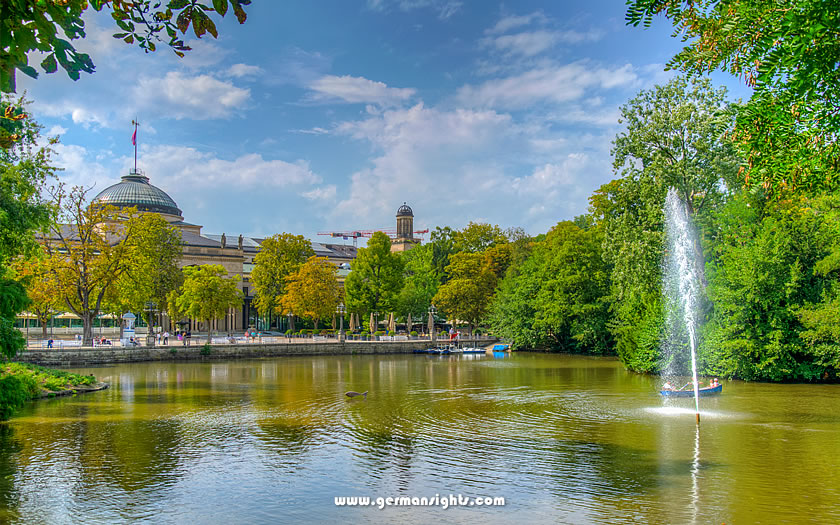
View of the Wiesbaden Kurhaus
A significant turning point came in 1815 when Wiesbaden became part of the Duchy of Nassau following the defeat of French Emperor Napoleon. This period of relative stability allowed for growth and development.
However political changes in Germany continued to shape the city's fate and, in 1866, Prussia annexed Wiesbaden after the Austro-Prussian War.
The late 19th century marked Wiesbaden's golden age. The city experienced rapid growth and transformed into a fashionable resort. Its popularity peaked when Kaiser Wilhelm II began making annual visits from 1894, cementing its status as a playground for European nobility and the upper classes
World War II brought significant challenges, with bombing raids causing extensive damage to the city. Wiesbaden became part of the newly formed state of Hesse after the war and served as the headquarters for the U.S. Army in Europe from 1945 to 1993.
Wiesbaden's history is visible in its grand 19th-century architecture, a testament to its heyday as a spa resort.
Wiesbaden's public transport is organised by the ESWE organisation and includes both buses and rail services in Wiesbaden and Mainz (in the 6500 zone). Local trains in the core area are included on ESWE tickets and both group and day tickets are available.
It is not a bad idea to check public transport options at the local tourist office. They may well offer the Wiesbaden Card as an alternative, which includes.
You can get the Wiesbaden Card in either 24 or 48-hour formats. It can be purchased at the tourist information centre or online.
This grand neo-classical building was built in 1907. It features an impressive columned entrance and houses a casino, restaurants, and concert halls.
The Kurpark is a sprawling park behind the Kurhaus, featuring a lake, fountains, and gardens. It hosts outdoor concerts in summer and offers a peaceful escape from the city.
The Neroberg is a 245-metre-high hill offering panoramic views of Wiesbaden and the Rhine Valley. It's accessible via a water-powered funicular railway built in 1888. The hill is popular for hiking and picnics.
The Griechische Kapelle is a Russian Orthodox church on the Neroberg that was built in the 1850s as a mausoleum for Duke Adolf of Nassau's wife. Its golden domes are visible from many parts of the city.
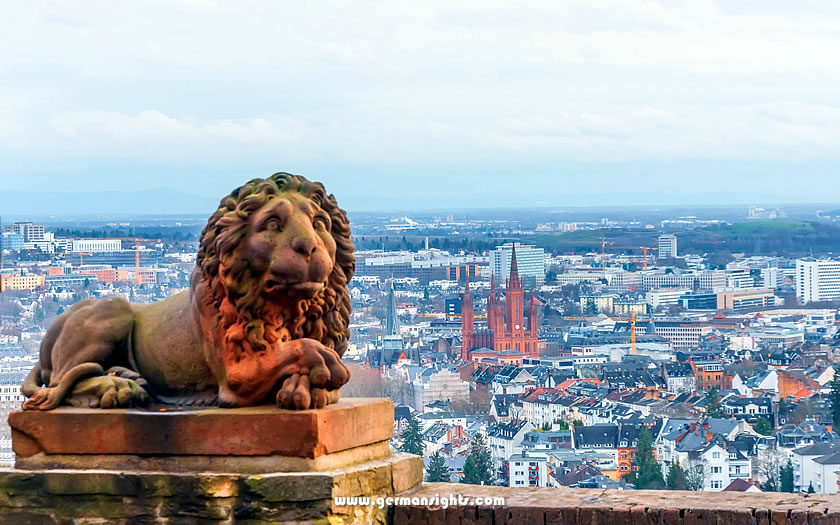
On the Neroberg hill
This Protestant church, completed in 1862, dominates Wiesbaden's skyline with its five red brick spires. Its neo-Gothic style stands out among the city's predominantly classical architecture.
Biebrich Palace is a baroque residential complex on the Rhine, built in the early 18th century. Its riverside gardens are open to the public and offer a pleasant spot for walks.
The museum houses three collections: art nouveau, old masters, and natural history. It's particularly known for its works by Alexej von Jawlensky and its extensive collection of stuffed birds.
This neoclassical theatre hosts a variety of performances including opera, ballet, and plays. Its history dates back to 1894.
These Roman ruins date back to the 3rd century AD, making them the oldest structures in Wiesbaden. They're a reminder of the city's ancient origins as a Roman fort.
There's plenty to explore in Wiesbaden itself, but its location in the Rhine valley makes it a great base for day trips to nearby attractions. Here are some ideas for independent day trips to consider during your stay in the Hessian state capital:
Start with a 30-minute drive or train ride to Rüdesheim.
When you get there, take the cable car for stunning views of the vineyards and visit the Niederwald Monument.
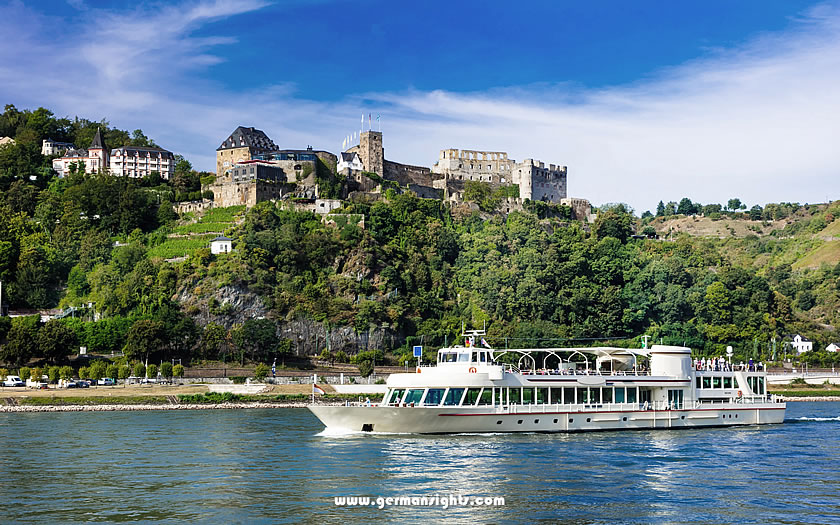
A Rhine river cruise passing Rheinfels castle
From Rüdesheim, board a Rhine river cruise to St. Goarshausen, enjoying the scenic valley and its castles. Once you have arrived in St. Goarshausen, explore the impressive Rheinfels Castle ruins.
Return to Wiesbaden by train or boat, depending on your preference and schedule.
Take the 45-minute train journey to Frankfurt.
Begin your exploration at the Römerberg, the city's historic centre, and visit the nearby Frankfurt Cathedral. Then cross the river Rhine and spend time exploring the Museum Embankment, home to numerous world-class museums.
If you have time and you fancy a bird's-eye view of the city, head up the Main Tower. Finish your day shopping on the Zeil, Frankfurt's bustling main shopping street.
Travel to Heidelberg by car or train, about a 90-minute journey.
Start your exploration at Heidelberg Castle, with its ruins and the famous giant wine barrel. Descend to the charming Altstadt (Old Town) and wander through its picturesque streets.
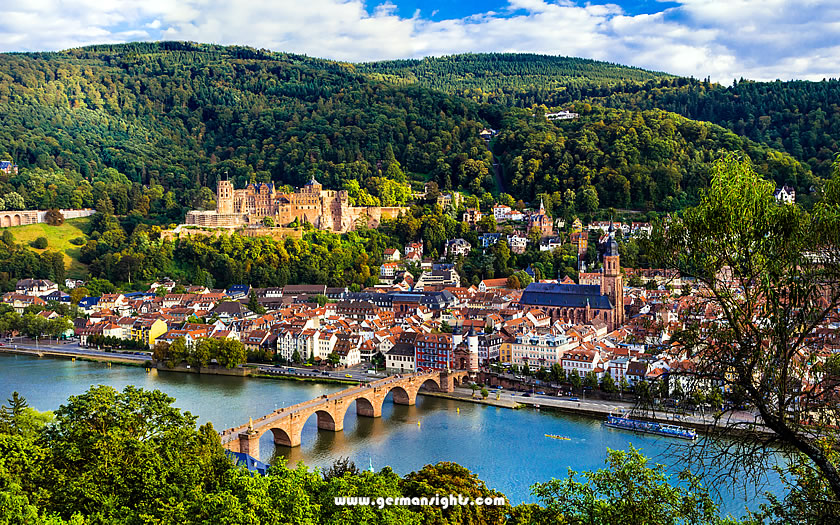
A view over Heidelberg in southwestern Germany
Cross the Old Bridge for classic views of the castle and river. Don't miss the quirky Student Prison museum before heading back to Wiesbaden.
The Rheingauer Weinwoche ('Rheingau Wine Festival') is one of the biggest wine events in Europe and celebrates the wine and sekt from the region over 10 days in Wiesbaden in August.
The Sternschnuppenmarkt is what Wiesbaden calls its Christmas market. This takes place during the Advent period on the Schlossplatz and in front of the Marktkirche. It also features a ferris wheel and a specially constructed 'Christmas tavern'.
Video of the Ferris wheel and tavern at the Wiesbaden Christmas market
Other festivities include the Frühlingsfest ('Spring Market') and the Wilhelmstrassenfest, one of Germany's largest street festivals held in June.
The tourist information office in Wiesbaden is located on the Marktplatz (the 'Market Square') near the Town Hall and the Marktkirche. It is open six days a week from 10.00-18.00.
Tourist Office: tourismus.wiesbaden.de